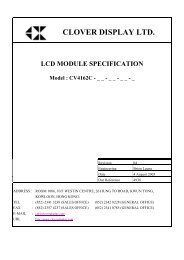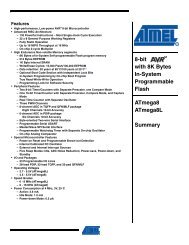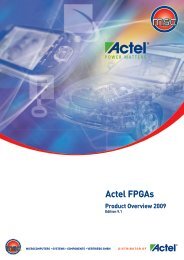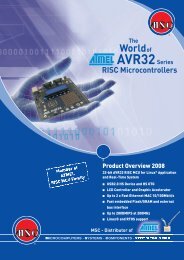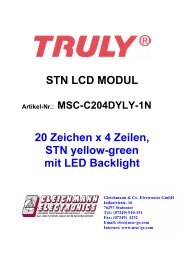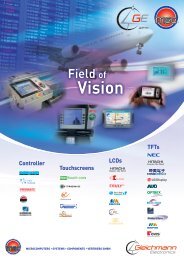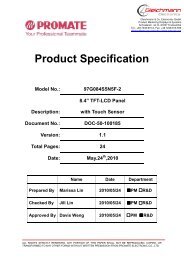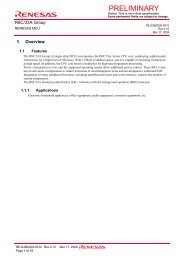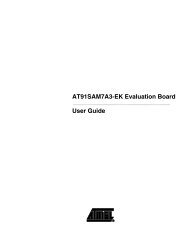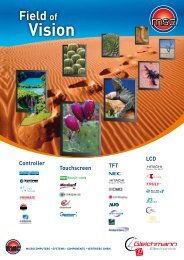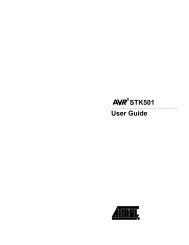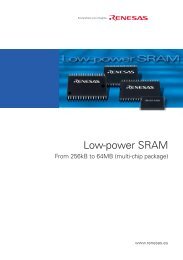SL811HS Embedded USB Host/Slave Controller
SL811HS Embedded USB Host/Slave Controller
SL811HS Embedded USB Host/Slave Controller
Create successful ePaper yourself
Turn your PDF publications into a flip-book with our unique Google optimized e-Paper software.
<strong>SL811HS</strong><br />
<strong>USB</strong>-A/<strong>USB</strong>-B <strong>Host</strong> Control Registers [Address = 00h, 08h] .<br />
Table 3. <strong>USB</strong>-A/<strong>USB</strong>-B <strong>Host</strong> Control Register Definition [Address 00h, 08h]<br />
Bit 7 Bit 6 Bit 5 Bit 4 Bit 3 Bit 2 Bit 1 Bit 0<br />
Preamble Data Toggle Bit SyncSOF ISO Reserved Direction Enable Arm<br />
Bit Position Bit Name Function<br />
7 Preamble If bit = ’1’ a preamble token is transmitted before transfer of low speed packet. If bit = ’0’,<br />
preamble generation is disabled.<br />
• The <strong>SL811HS</strong> automatically generates preamble packets when bit 7 is set. This bit is only<br />
used to send packets to a low speed device through a hub. To communicate to a full<br />
speed device, this bit is set to ‘0’. For example, when <strong>SL811HS</strong> communicates to a low<br />
speed device via the HUB:<br />
— Set <strong>SL811HS</strong> SIE to operate at full speed, i.e., bit 5 of register 05h (Control Register 1)<br />
= ’0’.<br />
— Set bit 6 of register 0Fh (Control Register 2) = ’0’. Set correct polarity of DATA+ and<br />
DATA– state for full speed.<br />
— Set bit 7, Preamble bit, = ’1’ in the <strong>Host</strong> Control register.<br />
• When <strong>SL811HS</strong> communicates directly to a low speed device:<br />
— Set bit 5 of register 05h (Control Register 1) = ’1’.<br />
— Set bit 6 of register 0Fh (Control Register 2) = ’1’, DATA+ and DATA– polarity for low<br />
speed.<br />
— The state of bit 7 is ignored in this mode.<br />
6 Data Toggle Bit ’0’ if DATA0, ’1’ if DATA1 (only used for OUT tokens in host mode).<br />
5 SyncSOF ’1’ = Synchronize with the SOF transfer when operating in FS only.<br />
The <strong>SL811HS</strong> uses bit 5 to enable transfer of a data packet after a SOF packet is transmitted.<br />
When bit 5 = ‘1’, the next enabled packet is sent after next SOF. If bit 5 = ‘0’ the next packet<br />
is sent immediately if the SIE is free. If operating in low speed, do not set this bit.<br />
4 ISO When set to ’1’, this bit allows Isochronous mode for this packet.<br />
3 Reserved Bit 3 is reserved for future use.<br />
2 Direction When equal to ’1’ transmit (OUT). When equal to ’0’ receive (IN).<br />
1 Enable If Enable = ’1’, this bit allows transfers to occur. If Enable = ’0’, <strong>USB</strong> transactions are ignored.<br />
The Enable bit is used in conjunction with the Arm bit (bit 0 of this register) for <strong>USB</strong> transfers.<br />
0 Arm Allows enabled transfers when Arm = ’1’. Cleared to ’0’ when transfer is complete (when<br />
Done Interrupt is asserted).<br />
Once the other <strong>SL811HS</strong> Control registers are configured (registers 01h-04h or 09h-0Ch) the <strong>Host</strong> Control register is programmed<br />
to initiate the <strong>USB</strong> transfer. This register initiates the transfer when the Enable and Arm bit are set as described above.<br />
<strong>USB</strong>-A/<strong>USB</strong>-B <strong>Host</strong> Base Address [Address = 01h, 09h] .<br />
Table 4. <strong>USB</strong>-A/<strong>USB</strong>-B <strong>Host</strong> Base Address Definition [Address 01h, 09h]<br />
Bit 7 Bit 6 Bit 5 Bit 4 Bit 3 Bit 2 Bit 1 Bit 0<br />
HBADD7 HBADD6 HBADD5 HBADD4 HBADD3 HBADD2 HBADD1 HBADD0<br />
The <strong>USB</strong>-A/B Base Address is a pointer to the <strong>SL811HS</strong> memory buffer location for <strong>USB</strong> reads and writes. When transferring<br />
data OUT (<strong>Host</strong> to Device), the <strong>USB</strong>-A and <strong>USB</strong>-B <strong>Host</strong> Base Address registers can be set up before setting ARM on the <strong>USB</strong>-A<br />
or <strong>USB</strong>-B <strong>Host</strong> Control register. When using a double buffer scheme, the <strong>Host</strong> Base Address could be set up with the first buffer<br />
used for DATA0 data and the other for DATA1 data.<br />
Document 38-08008 Rev. *D Page 5 of 32<br />
[+] Feedback



